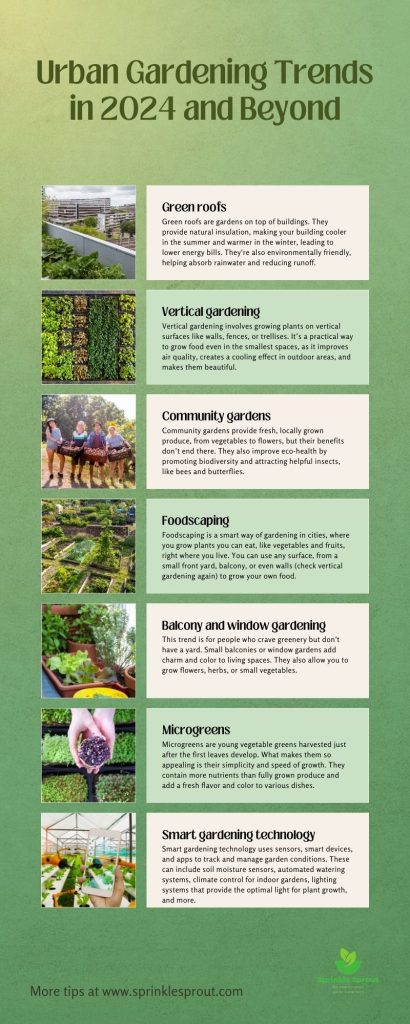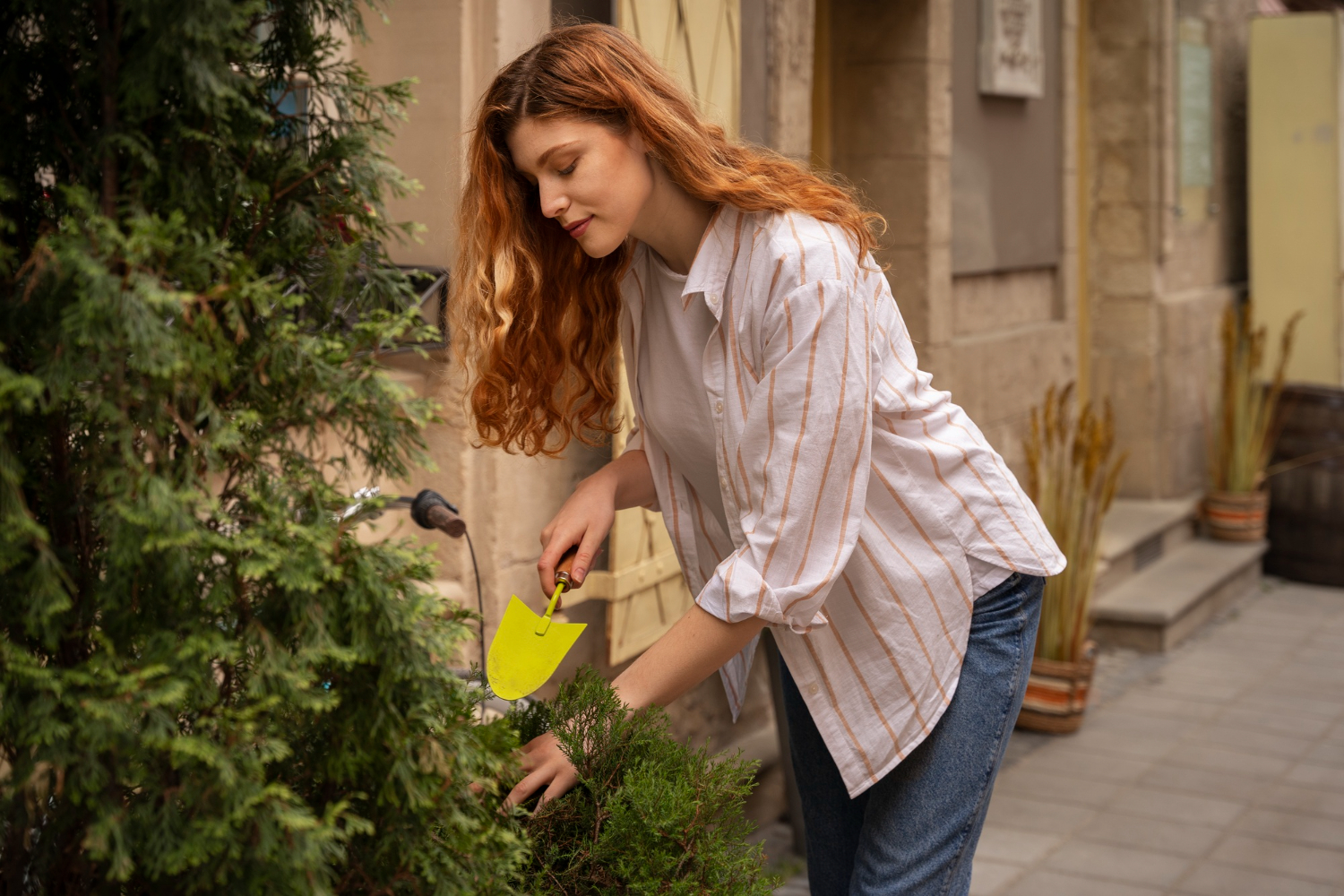Discover the latest trends in cultivating green spaces in the city to inspire your next step toward urban gardening.
Living in the city doesn’t mean you have to give up on greenery. In fact, it’s quite the opposite! Urban gardening is becoming increasingly popular, and it’s about finding creative ways to bring nature to your doorstep. Whether you have a small balcony, a rooftop, or just a sunny window, there’s always room for plants.
In this guide, we will explore some great urban gardening trends. From rooftop gardens to cozy balconies filled with flowers, we have many ideas to help you transform your urban space into a green sanctuary.
1. Green Roofs
Green roofs are gardens on top of buildings. Besides being a green oasis in a concrete jungle, they have practical purposes. They provide natural insulation, making your building cooler in the summer and warmer in the winter, leading to lower energy bills. They’re also environmentally friendly, helping absorb rainwater and reducing runoff.
Starting a green roof might seem like a big project, but it’s doable. First, check if your roof can handle the extra weight. A structural engineer or architect can evaluate your roof’s strength and load-bearing capabilities. Local building regulations often include precise standards and restrictions for rooftop loads. You can discover them online or at your local government’s planning office/building department.
Next, determine the weight of the green roof. Includes the weight of soil (particularly when wet), plants, containers, furniture, water features, and other structures such as pergolas or pathways. Then, pick the right plants. Go for species that don’t need much soil and can handle extreme weather. Succulents or native grasses are usually a safe bet.
Start small with container gardens, and expand as you get more comfortable with the setup. Remember to install a waterproof layer and proper drainage to keep things tidy.
2. Vertical Gardening
Vertical gardening involves growing plants on vertical surfaces like walls, fences, or trellises. It is a practical way to grow food even in the smallest spaces. It improves air quality, create a cooling effect in outdoor areas and make them beautiful.
Choose a sunny wall or fence as your base to start vertical gardening. Use hanging planters, shelves, or trellis systems to hold your plants. Opt for grown varieties, like tomatoes, cucumbers, lettuce, chives, basil, parsley, oregano, various types of berries, grapes, kiwi, or cascading flowers. With some creativity, you can turn any wall into a lush garden and enhance your urban living.

3. Community Gardens
City dwellers can have nature at their doorstep by turning shared urban spaces into community gardens. These gardens provide fresh, locally grown produce, from vegetables to flowers, but their benefits don’t end there. They also improve eco-health by promoting biodiversity and attracting helpful insects, like bees and butterflies.
To get involved, check for an existing community garden in your area or consider starting one. You’ll need a plot of land, local authorities’ permission, and a group of neighbors. Community gardens help build relationships and encourage people to learn from each other. You can plan, plant, and maintain the garden together, making it a gathering place for plants and people.
4. Foodscaping
Foodscaping is a smart way of gardening in cities, where you grow plants you can eat, like vegetables and fruits, right where you live. You can use any surface – a small front yard, balcony, or even walls (check vertical gardening again) to grow your own food. This is really helpful in cities where there’s not a lot of space for big gardens.
Foodscaping, also known as edible landscaping, makes your neighborhood look nice with all the greenery, and it gives you fresh, healthy food to eat. It’s good for the environment too. By growing food in the city, you help more plants and animals survive, and you don’t need to bring in food from far away, which saves on pollution from trucks.
Foodscaping also brings people in the city together. Neighbors can share gardening tips and help each other grow different kinds of species. It’s a way to learn about nature and how to take care of it. Plus, it makes the city a greener, healthier place for everyone.
5. Balcony and Window Gardening
This trend is for people who crave for greenery but don’t have a yard. Small balconies or window gardens add charm and color to living spaces. They also allow you to grow flowers, herbs, or small vegetables.
For sunny balconies and windows, choose:
- Flowers like petunias, geraniums, and marigolds.
- Vegetables like tomatoes, peppers, and eggplants. They love the sun and can do well in containers.
- Fruits like strawberries and dwarf citrus trees (like lemon or lime). They are great for sunny areas and can be grown in pots.
For shady spaces, choose:
- Flowers like begonias, impatiens, and fuchsia.
- Leafy greens like lettuce, spinach, and Swiss chard. These species tolerate shade and are perfect for cooler, less sunny spots.
- Although most fruit requires sun, some raspberry and blueberry sorts tolerate partial shade.
Use containers that fit your space and have proper drainage. With some care, these tiny gardens can flourish, bringing life and beauty to your urban home.
6. Indoor Gardening
Indoor gardening allows you to grow decorative houseplants, herbs, and even some fruits and vegetables. These plants look nice, provide a food source, improve air quality and create a relaxing home environment. Talking about multi-purpose!
When starting your indoor garden, select plants suitable for indoor conditions. Snake plants, philodendrons, and peace lilies are excellent for areas with limited light. Grow basil and rosemary in brighter spots or even small chili peppers.
Make sure your plants are in containers with good drainage. Place them where they’ll receive appropriate light. With the proper care, your indoor garden will thrive, transforming your living space into a green, serene oasis.
7. Microgreens
Microgreens are young vegetable greens harvested just after the first leaves develop. What makes them so appealing is their simplicity and speed of growth. They contain 40% more nutrients than fully grown produce and add a fresh flavor and color to various dishes, from salads to sandwiches.
A microgreen garden requires minimal space and equipment. You can grow these plants on a sunny windowsill or under a grow light. You only need a shallow tray, potting soil, and some seeds. Popular options include radishes, peas, and salad greens. Keep the soil moist, and within a week or two, you’ll have a fresh crop of microgreens ready to harvest and enjoy.
8. Soilless Cultivation
Soilless cultivation is ideal for anyone lacking garden space or poor soil quality. It involves using alternative growing mediums to give plants nutrients and growth support.
The beauty of soilless cultivation is in its versatility and efficiency. It allows gardeners to grow plants in much smaller spaces and is often associated with higher yield and faster growth. It also reduces the risk of soil-borne diseases and pests, making gardening more manageable and successful.
Soilless cultivation requires less water, as systems recycle water and nutrients. This efficiency makes it a sustainable choice for the eco-conscious gardener.
The most common soilless cultivation methods include aeroponics and hydroponics.
- Aeroponics involves growing plants in an air or mist environment without soil. Plants are suspended in the air, misting their roots with a nutrient-rich solution. Aeroponics uses less water than traditional gardening and can result in faster growth. Suitable species to grow include tomato, lettuce, cucumber, leafy greens, eggplant, green beans, strawberries, and herbs.
- Hydroponics involves growing plants in a water-based, nutrient-rich solution. An inert medium like perlite or clay pellets supports roots. This method allows precise control over nutrients and water, leading to intense plant growth. It’s ideal for growing herbs, leafy greens, eggplants, peas, peppers, strawberries and blueberries.
Both methods reduce the need for space and eliminate soil-borne pests and diseases. They particularly appeal to those interested in sustainable and efficient urban gardening practices.
9. Smart Gardening Technology
Smart gardening technology includes the Internet of Things (IoT) and automation. It uses sensors, smart devices, and apps to track and manage garden conditions. These can include:
- Soil moisture sensors
- Automated watering systems
- Climate control for indoor gardens
- Lighting systems that provide the optimal light spectrum for plant growth.
Simply put, your garden can water itself or adjust its light based on the time of day.
Innovative technology contributes to healthier plants and higher yields. These systems make gardening easier for people without traditional gardening knowledge. They can guide and advise on the best care practices.
10. Urban Farming Co-ops
As part of the farm-to-table movement, urban farming cooperatives are becoming popular in cities. City people can get fresh produce from these co-ops. They promote healthy dier and reduces the environmental harm of long-distance food travel. They also function as communal gathering places, connecting people with their food and one another.
When you join an urban farming co-op, you get to do everything from planting to distributing produce. These co-ops teach the community about sustainable farming, making them important for city life.
Choose Your Favorite Urban Gardening Trend
With urban gardening trends like green roofs, vertical cultivation, and foodscaping, even the smallest spaces can become lush, green areas full of fresh food. So, whether you have a tiny balcony garden or a community garden, there’s a world of green possibilities waiting for you in the city’s heart. Explore these trends and see how you can add some green to your urban space!
